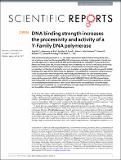| dc.contributor.author | Wu, Jing | |
| dc.contributor.author | de Paz, Alexandra | |
| dc.contributor.author | Zamft, Bradley M. | |
| dc.contributor.author | Marblestone, Adam H. | |
| dc.contributor.author | Kording, Konrad P. | |
| dc.contributor.author | Tyo, Keith E. J. | |
| dc.contributor.author | Boyden, Edward | |
| dc.date.accessioned | 2018-02-13T14:50:51Z | |
| dc.date.available | 2018-02-13T14:50:51Z | |
| dc.date.issued | 2017-07 | |
| dc.date.submitted | 2016-11 | |
| dc.identifier.issn | 2045-2322 | |
| dc.identifier.uri | http://hdl.handle.net/1721.1/113619 | |
| dc.description.abstract | DNA polymerase (pol) processivity, i.e., the bases a polymerase extends before falling off the DNA, and activity are important for copying difficult DNA sequences, including simple repeats. Y-family pols would be appealing for copying difficult DNA and incorporating non-natural dNTPs, due to their low fidelity and loose active site, but are limited by poor processivity and activity. In this study, the binding between Dbh and DNA was investigated to better understand how to rationally design enhanced processivity in a Y-family pol. Guided by structural simulation, a fused pol Sdbh with non-specific dsDNA binding protein Sso7d in the N-terminus was designed. This modification increased in vitro processivity 4-fold as compared to the wild-type Dbh. Additionally, bioinformatics was used to identify amino acid mutations that would increase stabilization of Dbh bound to DNA. The variant SdbhM76I further improved the processivity of Dbh by 10 fold. The variant SdbhKSKIP241-245RVRKS showed higher activity than Dbh on the incorporation of dCTP (correct) and dATP (incorrect) opposite the G (normal) or 8-oxoG(damaged) template base. These results demonstrate the capability to rationally design increases in pol processivity and catalytic efficiency through computational DNA binding predictions and the addition of non-specific DNA binding domains. | en_US |
| dc.description.sponsorship | National Institutes of Health (U.S.) (Award 5R01MH103910-02) | en_US |
| dc.publisher | Nature Publishing Group | en_US |
| dc.relation.isversionof | http://dx.doi.org/10.1038/S41598-017-02578-3 | en_US |
| dc.rights | Creative Commons Attribution 4.0 International License | en_US |
| dc.rights.uri | https://creativecommons.org/licenses/by/4.0/ | en_US |
| dc.title | DNA binding strength increases the processivity and activity of a Y-Family DNA polymerase | en_US |
| dc.type | Article | en_US |
| dc.identifier.citation | Wu, Jing et al. “DNA Binding Strength Increases the Processivity and Activity of a Y-Family DNA Polymerase.” Scientific Reports 7, 1 (July 2017): 4756 © The Author(s) 2017 | en_US |
| dc.contributor.department | Massachusetts Institute of Technology. Department of Biological Engineering | en_US |
| dc.contributor.department | Massachusetts Institute of Technology. Media Laboratory | en_US |
| dc.contributor.department | McGovern Institute for Brain Research at MIT | en_US |
| dc.contributor.mitauthor | Boyden, Edward | |
| dc.relation.journal | Scientific Reports | en_US |
| dc.eprint.version | Final published version | en_US |
| dc.type.uri | http://purl.org/eprint/type/JournalArticle | en_US |
| eprint.status | http://purl.org/eprint/status/PeerReviewed | en_US |
| dc.date.updated | 2018-02-09T16:35:26Z | |
| dspace.orderedauthors | Wu, Jing; de Paz, Alexandra; Zamft, Bradley M.; Marblestone, Adam H.; Boyden, Edward S.; Kording, Konrad P.; Tyo, Keith E. J. | en_US |
| dspace.embargo.terms | N | en_US |
| dc.identifier.orcid | https://orcid.org/0000-0002-0419-3351 | |
| mit.license | PUBLISHER_POLICY | en_US |
